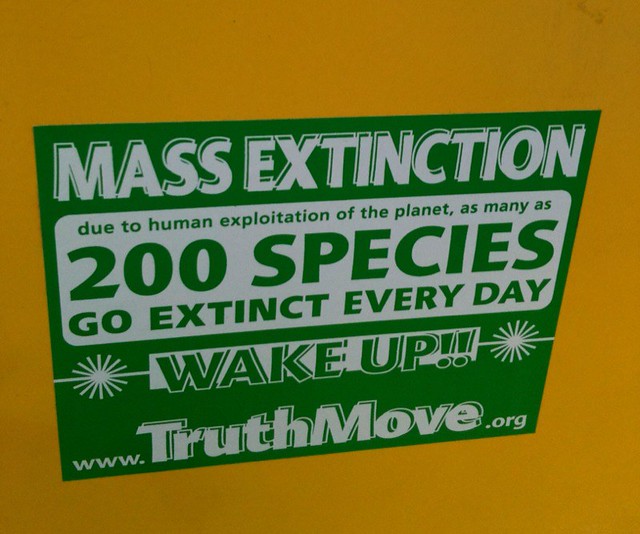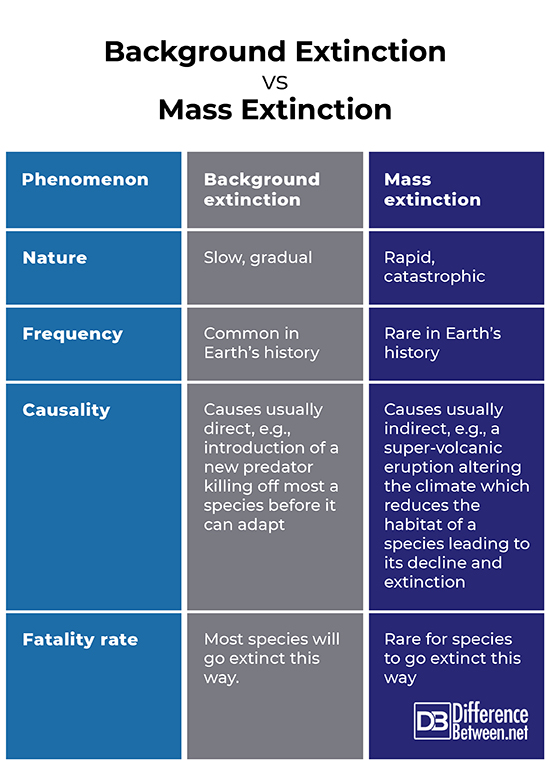Difference Between Background Extinction and Mass Extinction

What is the Background of Extinction?
Background extinction refers to the slow process by which a small percentage of species at any given time go extinct over the course of the history of life on Earth. Background extinction is not well studied but is considered by some researchers to be a function of declining reproductive fitness and decreasing ability to adapt to environmental changes.
Reproductive fitness and background extinction
In evolutionary biology, the phrase “survival of the fittest” refers to reproductive fitness. Reproductive fitness refers to the ability of an organism to produce fertile offspring that are able to live long enough to produce fertile offspring themselves. Traits that favor an organism’s survival will be preferentially selected. Those that do not favor an organism’s survival will be selected against in a population. This is how natural selection works.
Species in which organisms fail to reproduce, or fail to reproduce sufficiently, are in danger of extinction. If the ability of a species to produce fertile offspring in their environment decreases over time, they may eventually go extinct. This is often how background extinction happens.
Factors involved in background extinction
Primary processes that appear to be involved in background extinction are climate change and habitat infiltration by invasive species. Species will continue to survive as long as their environment stays within parameters to which they can successfully adapt. If the environment changes so that it exceeds these parameters before a species has time to adapt, members of that species will find it harder to survive and reproduce.
One example is the modern fate of lizards in tropical areas with rising temperatures. Lizards require sunbathing to warm their bodies in order to hunt effectively, but they also need to have time in the shade to cool down. This is so that their body temperature does not endanger their physiological functions.
In some tropical regions, temperatures are getting high enough, due to climate change, that female lizards must seek shade before they have hunted long enough to gain the nutrient requirements for reproduction. This is causing a decline in tropical lizard populations.
Another common cause of background extinction is the introduction of new predators. Often, invasive predators will change the environment in a manner that will be too rapid for prey species to adapt. This can lead to major extinction events. One example of this might be the extinction of many Australian megafauna with the arrival of the first humans on the continent.
In general, background extinction is not sudden in geological or biological terms but usually happens gradually as a species loses reproductive fitness over time due to environmental changes happening too fast for the species to adapt.

What is a Mass Extinction?
When an event causes 75% or more of present species to go extinct over a geologically short period of time, usually hundreds of thousands to millions of years, it is called a mass extinction. Mass extinctions are geologically sudden and typically involve multiple phenomena that all converge to create “a very bad day” for the organisms alive at the time.
Geologists and paleontologists believe that there have been at least five major mass extinctions across the last 500 million years. These mass extinctions are important in that they are used to mark major Geologic time periods. For example, the Mesozoic Era begins with the Permian-Triassic mass extinction 251 million years ago and ends with the Cretaceous-Tertiary mass extinction 66 million years ago that killed the dinosaurs and ammonites, among other organisms.
The Permian mass extinction was the worst mass-extinction in the history of life in which an estimated 96% of life-forms went extinct. The mass extinction is attributed to multiple factors including the possible eruption of a supervolcano which resulted in temperature increases due to greenhouse gases. Meanwhile, an explosion of certain micro-organisms may have led to the production of copious amounts of hydrogen sulfide which is poisonous to most life on Earth.
The mass extinction that killed the dinosaurs is so far the only one which has been definitively linked to an extraterrestrial object. Right before the mass extinction event, an asteroid collided with Earth, impacting what is now the Yucatan Peninsula on the southern edge of the Gulf of Mexico. The Cretaceous-Tertiary mass extinction was likely caused by a combination of the impact and flood basalts which formed what are now the Deccan Traps in modern India.
Similarities between Background Extinction and Mass Extinction
Both types of extinctions involve the disappearance of species. Also, both forms of extinction involve changes happening too fast for a population or species to successfully adapt.
Differences between Background Extinction and Mass Extinction
Although there are similarities between background extinctions and mass extinctions, there are also important differences. These include the following.
- Background extinctions are usually slow and gradual, whereas mass extinctions happen rapidly and catastrophically in geological terms.
- Background extinctions are common since a small number of species will go extinct at any point across geologic time, whereas mass extinctions are rare events, happening only once about every 100 million years.
- Background extinctions involve processes that directly affect the reproductive fitness of an organism, whereas mass extinctions involve catastrophic processes that usually do not directly cause the extinction of an organism.
- Most extinct species have gone extinct due to background extinction events, whereas relatively few have gone extinct due to mass extinction events.Background Extinction Vs. Mass Extinction

Summary
Background extinction involves the decline of the reproductive fitness within a species due to changes in its environment. These changes can include climate change or the introduction of a new predator. Background extinction tends to be slow and gradual but common with a small percentage of species at any given time fading into extinction across Earth’s history. Mass extinction involves the death of 75% or more of species in a geologically short period of time due to catastrophic events. A mass extinction usually involves multiple events occurring simultaneously which overwhelm the biosphere, leading to massive die-offs. Background extinction and mass extinction are similar in that they both involve the disappearance of species due to changes in the environment. They differ, however, in that background extinction tends to be a slow and gradual process, whereas mass extinctions are geologically rapid and catastrophic. Also, background extinctions tend to be common, whereas mass extinctions are rare. Furthermore, background extinction is driven by processes that directly affect the reproductive fitness of a species, such as the disappearance of a suitable habitat, whereas mass extinctions tend to be caused by processes that may only indirectly affect reproductive fitness. For example, an asteroid impact could raise a dust cloud into the atmosphere which could reduce sunlight, changing the climate, and thus an organism’s habitat. It is the change in habitat conditions which will directly affect the organism’s survival rather than the asteroid. Relatively few organisms and even fewer species will be directly wiped out by the impact itself. Also, most species will go extinct through background extinction. Only a small percentage will go extinct in mass-extinctions.
- Difference Between Environmental Performance Index and Development - November 24, 2023
- Difference Between Environmental Intervention and Development - November 8, 2023
- Difference Between Eco Efficiency and Eco Effectiveness - September 18, 2023
Search DifferenceBetween.net :
Leave a Response
References :
[0]Cosmos Contributor. “The big five mass extinctions.” Cosmos Magazine, N.D., https://cosmosmagazine.com/palaeontology/big-five-extinctions, 22 Feb. 2020.
[1]The Editors of Encyclopedia Britannica. “Natural Selection.” Encyclopedia Britannica, Encyclopedia Britannica, inc., 3 Feb. 2020, https://www.britannica.com/science/natural-selection, 24 Feb. 2020.
[2]Tarlach, Gemma. “The Five Mass Extinctions That Have Swept Our Planet.” Discover Magazine, 18 July 2018, https://www.discovermagazine.com/the-sciences/mass-extinctions. Accessed 22 Feb. 2020.
[3]Wiens, Delbert, and Michele R. Slaton. "The mechanism of background extinction." Biological Journal of the Linnean Society 105.2 (2012): 255-268.
[4]Image credit: https://upload.wikimedia.org/wikipedia/commons/5/5b/Bufo_periglenes2.jpg
[5]Image credit: https://live.staticflickr.com/2769/4167763137_c251aaaf2b_z.jpg
